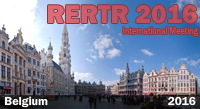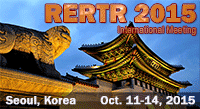Abstracts and Available Papers Presented at the
2002 International RERTR Meeting
DART THERMAL DEVELOPMENT AND VALIDATION OF AN IMPROVED VERSION OF THE DART CODE
Taboada, H1; Rest, J2; Moscarda, M. V1; Markiewicz, M1; Estévez, E1
1Comisión Nacional de Energía Atómica, República Argentina
2Argonne National Laboratory-United States of America
ABSTRACT
ANL/USDOE and CNEA Argentina have been participating within a SisterLab Program in the area of Low Enriched Uranium Advanced Fuels since October 16, 1997 under the “Implementation Arrangement for Technical Exchange and Cooperation in the Area of Peaceful Uses of Nuclear Energy.” An annex concerning DART code [1,2] optimization has been operative since February 8, 1999. Previously, as a part of this annex we developed a visual version of DART named FASTDART for silicide and U-Mo fuels that was presented at the RERTR Meeting in Las Vegas, Nevada [3].
This paper describes several major improvements in the FASTDART code: a thermal calculation subroutine, a fuel particle size distribution subroutine and several visual interfaces for thermal output plotting and particle size input.
Using the power history, coolant regime data and fuel dimensions, the new thermal subroutine is able to calculate at each time step the maximum temperature along the z-longitudinal axis as a function of plate/rod morphology (corrosion oxide, cladding, meat, aluminide particle layer, each radial shell of a central fuel particle, and particle center). Calculated temperatures at each time step are coupled to the DART calculation kernel such that swelling processes, volume phase fractions and meat thermal conductivity are calculated synergistically.
The new fuel particle size-distribution subroutine is essential in order to determine the evolution of the volume fraction of reaction product. This phase degrades the heat transport by a twofold mechanism: its appearance implies a diminution of aluminium phase and its thermal conductivity is lower than those of fuel and dispersant phase.
The new version includes the capability of plotting thermal data output by means of the plate/rod temperature profile at a given irradiation step, and displaying the maximum temperature evolution of each layer.
A comparison between the reaction layer thickness and matrix and fuel volume fractions of several RERTR-3 experiment miniplates and those calculated by DART THERMAL is included. A sound agreement was found which reveals an adequate DART THERMAL temperature calculation, since the layer grown depends strongly on temperature.
![]() PDF version available
PDF version available
DOWNLOAD full paper in PDF format.
Contact:
Dr. Horacio Taboada
MTR Fuels Simulation
Group
CNEA
Avda. del Libertador
8250
C1429BNO Buenos Aires, Argentina
Phone: (54 11) 4704
1143
Fax: (54 11) 4704
1193/4
E-mail: [email protected]




